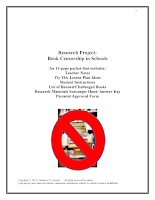This Sunday, September 24th, begins the American Library Association's week-long celebration of the "Right to Read."They are focusing this year's celebration on the First Amendment, "Congress shall make no law respecting an establishment of religion, or prohibiting the free exercise thereof; or abridging the freedom of speech, or of the press; or the right of the people peaceably to assemble, and to petition the Government for a redress of grievances," (https://www.constituteproject.org/constitution/United_States_of_America_1992.
This is a perfect time for students to explore their right to read what they want, when they want. They are shocked when they hear that some schools ban fairy tales written by the Grimm brothers such as Snow White and the Seven Dwarves (violence and sexual innuendo-Snow White lives with seven men), and Little Red Riding Hood (violence and alcohol infractions-underaged Little Red carries wine to her Grandmother). Then their attention is hooked when they find out that they have probably read at least one banned book since they started their formal education, and more than that through their independent reading.
In many elementary, middle, and high schools, teachers are often required to offer a second "safe" book when a controversial fiction or nonfiction book will be taught. Some do so just to keep possible challenges at bay. I remember being shocked when I found out that a parent of a student at a magnet school for only extremely high achieving high school students challenged the teaching of Ken Follett's, Pillars of the Earth. Her upset began at the start of the book when a number of medieval men and women were traveling between towns on foot and one of the women stopped along the side of the road to give birth. She felt this description was too graphic for her high school senior involved in the study of geriatric illnesses. In support of the right for teachers and administrators to choose what books their charges will study, many high schools in the same district started "We Read Banned Book" clubs for staff and students at their schools.
This list of the "Ten Most Commonly Banned Books" on the Butler University site (http://libguides.butler.edu/c.php?g=34189&p=217684) would decimate many middle and high school English program of studies if a person or group chose to challenge their inclusion in the district's students education.
- 1984 (George Orwell)
- The Adventures of Huckleberry Finn (Mark Twain)
- The Catcher in the Rye (J.D. Salinger)
- The Color Purple (Alice Walker)
- The Great Gatsby (F.Scott Fitzgerald)
- I Know Why the Caged Bird Sings (Maya Angelou)
- Lord of the Flies (William Golding)
- Of Mice and Men (John Steinbeck)
- One Flew Over the Cuckoo's Nest (Ken Kesey)
- To Kill a Mockingbird (Harper Lee)
Although many books are challenged by a person or group, not all of these are restricted in some form, such as not permitted in the school library or kept to specific grade levels, nor do they end up being banned-not allowed in school libraries or programs of study.
My product, "Writing Activity - Banned Books Research Project," gives students the chance to choose a banned book to read-with parental permission- and to research the reason(s) it has been banned. Students will explore
various facets of book censorship in schools to become more proficient in their
reading, critical thinking and writing skills. Whether they choose to
investigate the legal, historical, moral or societal aspects of this issue is up
to each individual student and his/her personal interest in this topic. In order to illustrate the points for book
censorship in the schools, students will read a frequently banned or challenged
novel, either from the included list, or a choice of their own. Next, they will
research when, where and why it was challenged or banned. In the last part of the paper, each student
will develop his/her opinion on whether the book should be banned or
restricted, using points from the paper to support his/her conclusion.
Here is a student project and five websites for teachers to use to plan their introductory discussion. Students will not only find the sites informative for their research, but will also uncover other links that will aid them in their investigation. Besides Teacher Notes, this packet offers a Permission Slip form students must get signed for the book they will read and research, specific project requirements for students, a list of 60 commonly banned books, and much more. Here is the link: https://www.teacherspayteachers.com/Product/Writing-Activity-Banned-Books-Research-Project-321767 $3.00
Banned Books links:
Students love to argue their viewpoint about the unfairness of restrictions- and they almost always find some aspect of a limitation unfair. This project
Shows them how to research and support an argument by exploring the fundamental right to read, Helps them to determine the best places to find the reasoning behind Pro and Con challenged book arguments, and
Lets them create and defend their opinions with logic and facts.
After completing this project, they will look at the books they read for class or for personal enjoyment with a clearer understanding of the controversy surrounding book banning.
Enjoy a Teach It Now Day Every Day.
Connie
https://www.teacherspayteachers.com/Store/Connie



No comments:
Post a Comment